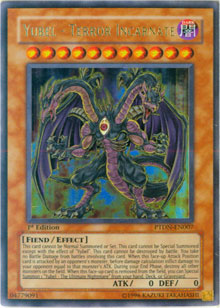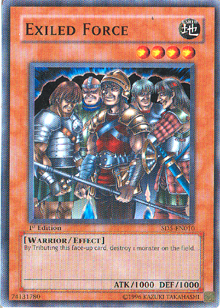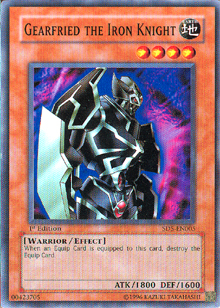Today we look at a few trigger effect subtleties.
Effect Resolution is Favorable/Not Favorable
Sometimes effects that resolve at chain link 1 won’t allow an optional trigger effect to activate and start a new chain because of the way the effect resolves. You don’t see this very often and it can be a bit tricky  when it does arise. The situation usually comes down to using individual card rulings to help us determine if this will be a problem.
when it does arise. The situation usually comes down to using individual card rulings to help us determine if this will be a problem.
When Ruthless Denial sends Yubel - Terror Incarnate and the opponent’s card to the graveyard, the two cards are treated as being sent to the graveyard at the same time. When this action is performed, the chain is done resolving and no further effects resolve, so it is possible to start a new chain with Yubel - Terror Incarnate’s effect.
When Goldd is discarded, its mandatory trigger effect is triggered. Since it has been discarded by the opponent’s card effect, both of its effects are applied. First it is special summoned, and next it destroys its targets. Goldd has no problem with its effects, but Card of Safe Return does. When Goldd’s effect resolves its effect in this situation, it doesn’t end with it being special summoned. Goldd’s effects end with the destruction of Player B’s cards, which isn’t the event Card of Safe Return is looking for. Card of Safe Return’s effect cannot be activated in this situation.
Priority Fails Utterly
Trigger effects are the bane of priority because they can make it impossible for you to use priority. Usually when you normal summon you can reserve priority to activate the ignition effect of one of your monsters, but this isn’t possible if a mandatory trigger effect activates as a result of your monster being  summoned. Since the mandatory trigger effect immediately activates and starts a chain in this situation, you are not able to activate an ignition effect. Doing so would be an attempt to chain a spell speed 1 effect (the ignition effect) to another spell speed 1 effect (in this case the trigger effect), and you can’t do that. These effects are not simultaneous.
summoned. Since the mandatory trigger effect immediately activates and starts a chain in this situation, you are not able to activate an ignition effect. Doing so would be an attempt to chain a spell speed 1 effect (the ignition effect) to another spell speed 1 effect (in this case the trigger effect), and you can’t do that. These effects are not simultaneous.
Usually Player A would be able to retain priority and activate Exiled Force’s effect. However that is not possible in this case. The mandatory trigger effect of Stumbling activates as soon as Exiled Force is summoned, which prevents Player A from activating its ignition effect. Player B can chain Trap Hole to Stumbling and destroy Exiled Force without Player A having any chance to use its effect.
Optional trigger effects are different, and true to form they are decidedly more complicated. If an optional trigger effect can be activated when your monster is normal summoned, you can only use priority if the optional trigger effect is not activated. If the optional trigger effect is activated, it is not possible to use priority to activate the ignition effect of another one of your monsters.
Player A cannot also use priority to activate Snipe Hunter’s effect. Player B can chain Bottomless Trap Hole to destroy Snipe Hunter and remove it from play. If Player A had decided not to activate Card of Safe Return’s effect, he could have used priority to activate Snipe Hunter’s effect and target the Summoned Skull.
Looks like a Trigger Effect, but It’s Not
We have some effects in the Yu-Gi-Oh! TCG that look like trigger effects, but that are technically classified as something else. I can’t really explain why they aren’t. Perhaps it is the quirky nature of Yu-Gi-Oh! or it is simply what the creators intended for these cards from the beginning. Regardless, these  cards are a reminder that you should always check the rulings for any card you play. (It also doesn’t hurt to check out the official judge forums)
cards are a reminder that you should always check the rulings for any card you play. (It also doesn’t hurt to check out the official judge forums)
Revival cards like Birthright, Call of the Haunted, and Glorious Illusion have an effect that says to destroy the special summoned monster when the revival card is removed from the field. This text is written very much like a trigger effect, but it is actually applied at the time the revival card is removed from the field. It does not start another chain, so you don’t get a chance to respond to this effect.
Gearfried the Iron Knight’s effect says to destroy any equip card attached to Gearfried when it becomes equipped. This text resembles a trigger effect, but it is actually a continuous effect that is applied at the time the equip card is attached.
Jirai Gumo and other similar monsters have text saying you must pay life points when the monster attacks. This is actually a cost, not a trigger effect.
When in doubt, check the rulings!
Until next time, send all comments and questions to Curtis@Metagame.com.
—Curtis Schultz